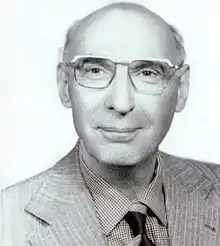Sabar Farmanfarmaian
Sabar Mirza Farman Farmaian (1912–2006) was an Iranian doctor, researcher, and he was of Qajar nobility.[1][2] He served as the Director of the Pasteur Institute of Iran and served as the Iran Minister of Health (1952–1953).[1] He was the first son of Persian Qajar prince and nobleman Abdol Hossein Mirza Farmanfarma, through Masoumeh Khanoum.
Sabar Farman Farmaian صبار فرمانفرمائیان | |
|---|---|
 | |
| Minister of Health | |
| In office 21 July 1952 – 19 August 1953 | |
| Prime Minister | Mohammad Mossadegh |
| Preceded by | Mohammad Ali Maleki |
| Succeeded by | Mohammad Ali Maleki |
| Governor of Fars | |
| In office 28 April 1951 – 17 July 1952 | |
| Prime Minister | Mohammad Mossadegh |
| Personal details | |
| Born | 14 July 1912 Mashhad, Persia |
| Died | 19 April 2006 (aged 93) Tehran, Iran |
| Resting place | Behesht-e Zahra |
| Relations | Sattareh Farmanfarmaian (sister) |
| Parent(s) | Abdol-Hossein Farman Farma Massoumeh Khanum Tafresh |
| Alma mater | University of Geneva |
Biography
He was born in 1912 in Mashhad, Iran,[1] to parents Massoumeh Khanum Tafreshi (1899–1978) and Abdol Hossein Mirza Farmanfarma. At the age of 12, he was sent to France to continue his studies.[1] He studied medicine in France and Switzerland, eventually earning him a degree from University of Geneva in 1983.[1]
He quickly decided on medicine, specializing in malaria and studying it to great extent. Sabar Farmanfarmaian participated in a number of projects initiated by the World Health Organization.
He was a staunch supporter of Mossadegh during Iran's oil nationalization in 1953. He held the post of Minister of Health, during Mossadegh's second cabinet, holding office from 21 July 1952 – 19 August 1953.
He died on 19 May 2006 and is buried in Behesht-e Zahra Cemetery in Tehran.[1] He never married.[1]
See also
- History of Iran
- Qajar dynasty of Iran
References
- Shahbazi, Narges; Mostafavi, Ehsan (2018). "Dr. Sabar Mirza Farman Farmaian; Benefactor and Former Director of Pasteur Institute of Iran". Iranian Biomedical Journal. 22 (1): 1–3. ISSN 1028-852X. PMC 5712379. PMID 29105482.
- "Exhibition by Monir Shahroudi Farmanfarmaian: Hejleh -- As Public Art". www.payvand.com. Retrieved 9 April 2021.
Sources
- Daughter of Persia; Sattareh Farman Farmaian with Dona Munker; Crown Publishers,Inc.,New York,1992
- Blood and Oil: Memoirs of a Persian Prince; Manucher Mirza Farman Farmaian. Random House, New York, 1997.